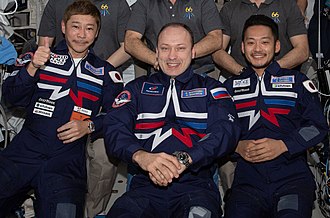
Back Ruimtetoerisme Afrikaans Turista espacial AN سياحة الفضاء Arabic Kosmik turizm Azerbaijani Космически туризъм Bulgarian Turisme espacial Catalan گەشتیاریی بۆشایی CKB Vesmírná turistika Czech Rumturisme Danish Weltraumtourismus German

| Part of a series on |
| Spaceflight |
|---|
 |
|
|
Space tourism is human space travel for recreational purposes.[1] There are several different types of space tourism, including orbital, suborbital and lunar space tourism. Tourists are motivated by the possibility of viewing Earth from space, feeling weightlessness, experiencing extremely high speed and something unusual, and contributing to science.[2]
Space tourism started in April 2001, when American businessman and engineer Dennis Tito became the first ever space tourist to travel to space aboard a Soyuz-TM32 spacecraft. During the period from 2001 to 2009, seven space tourists made eight space flights aboard a Russian Soyuz spacecraft to the International Space Station, brokered by American company Space Adventures in conjunction with Roscosmos and RSC Energia. Iranian-American businesswoman Anousheh Ansari became the first ever female space tourist in September 2006. The publicized price was in the range of US$20–25 million per trip. Some space tourists have signed contracts with third parties to conduct certain research activities while in orbit. By 2007, space tourism was thought to be one of the earliest markets that would emerge for commercial spaceflight.[3]: 11
Space tourists need to be in good physical form before going to space. In particular, they have to train for fast acceleration or g-forces in a centrifuge and weightlessness by flying in a high-altitude jet plane doing parabolic arcs. They may have to learn how to operate and even fix parts of the spaceship using simulators.
Russia halted orbital space tourism in 2010 due to the increase in the International Space Station crew size, using the seats for expedition crews that would previously have been sold to paying spaceflight participants.[4][5] Orbital tourist flights were set to resume in 2015 but the planned flight was postponed indefinitely.[6] Russian orbital tourism eventually resumed with the launch of Soyuz MS-20 in 2021.[7]
On June 7, 2019, NASA announced that starting in 2020, the organization aims to start allowing private astronauts to go on the International Space Station, with the use of the SpaceX Crew Dragon spacecraft and the Boeing Starliner spacecraft for public astronauts, which is planned to be priced at 35,000 USD per day for one astronaut,[8] and an estimated 50 million USD for the ride there and back.[9]
Work also continues towards developing suborbital space tourism vehicles. This is being done by aerospace companies like Blue Origin and Virgin Galactic. SpaceX announced in 2018 that they are planning on sending space tourists, including Yusaku Maezawa, on a free-return trajectory around the Moon on the Starship.[10][11]
In the future, space tourism might happen through space elevators, tourists might stay in luxury space hotels and spend vacation in a space colony (on the moon or on Mars).
- ^ Von der Dunk, F. G. (2011). "Space tourism, private spaceflight and the law: Key aspects". Space Policy. 27 (3): 146–152. Bibcode:2011SpPol..27..146V. doi:10.1016/j.spacepol.2011.04.015. ISSN 0265-9646. Archived from the original on November 26, 2020. Retrieved June 25, 2019.
- ^ Maharaj Vijay Reddy; Mirela Nica (October 2012), "Space tourism: Research recommendations for the future of the industry and perspectives of potential participants", Tourism Management, 33 (5): 1093–1102
{{citation}}: Unknown parameter|auhtor3=ignored (|author3=suggested) (help) - ^ Belfiore, Michael (2007). Rocketeers: how a visionary band of business leaders, engineers, and pilots is boldly privatizing space. New York: Smithsonian Books. p. [1]. ISBN 978-0-06-114903-0.
- ^ "Russia halts space tours as U.S. retires Shuttle". Reuters. March 3, 2010. Archived from the original on April 30, 2013.
- ^ "Russia will restore space tourism since 2012" (in Russian). Interfax. March 18, 2010. Archived from the original on July 28, 2011. Retrieved March 18, 2010.
- ^ "Citizen Exploration". Citizens in Space. February 1, 2012. Archived from the original on March 8, 2012. Retrieved March 14, 2012.
- ^ "Soyuz MS-20 space tourism flight docks with ISS". NASASpaceflight.com. December 7, 2021. Retrieved December 10, 2021.
- ^ "NASA to open International Space Station to tourists". BBC. June 7, 2019. Archived from the original on June 8, 2019. Retrieved June 8, 2019.
- ^ "Yes, NASA would be happy to have you aboard the space station. But it'll cost some $50 million". The Washington Post. June 22, 2020. Archived from the original on December 1, 2020. Retrieved December 23, 2020.
- ^ Eric Ralph (September 14, 2018). "SpaceX has signed a private passenger for the first BFR launch around the Moon". Archived from the original on September 14, 2018. Retrieved September 14, 2018.
- ^ Grush, Loren (September 14, 2018). "SpaceX says it will send someone around the Moon on its future monster rocket". The Verge. Archived from the original on September 14, 2018. Retrieved September 15, 2018.
© MMXXIII Rich X Search. We shall prevail. All rights reserved. Rich X Search